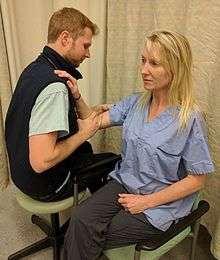Shoulder reduction
Shoulder reduction is the process of returning the shoulder to its normal position following a shoulder dislocation. Normally, closed reduction, in which the relationship of bone and joint is manipulated externally without surgical intervention, is used. A variety of techniques exist, but some are preferred due to fewer complications or easier execution.[1] In cases where closed reduction is not successful, open (surgical) reduction may be needed.[2] X-rays are often used to confirm success and absence of associated fractures. The arm should be kept in a sling or immobilizer for several days, prior to supervised recovery of motion and strength.
| Shoulder reduction |
|---|
Various non-operative reduction techniques are employed. They have certain principles in common, including gentle in-line traction, reduction or abolition of muscle spasm, and gentle external rotation. They all strive to avoid inadvertent injury. Two of them, the Milch and Stimson techniques, have been compared in a randomized trial.[3] Pain can be managed during the procedures either by procedural sedation and analgesia or by injecting lidocaine into the shoulder joint.[4]
External rotation
The person's arm is brought against their side.[2] The elbow is then bent to 90 degrees and the forearm is slowly and gently externally rotated.[2] Any discomfort or spasm interrupts the process until the person is able to relax. Reduction usually takes place by the time full external rotation has been achieved.[5]
Milch
This is an extension of the external rotation technique. The externally rotated arm is gently abducted (brought away from the body into an overhead position) while external rotation is maintained. Gentle in-line traction is applied to the arm while some pressure is applied to the humeral head via the operator's thumb in the armpit to keep the head from moving inferiorly.[2][6]
Stimson

In the Stimson technique, also known as prone technique, the person lies on their stomach on a bed or bench and the arm hangs off the side, being allowed to drop toward the ground. A 5–10 kg weight is suspended from the wrist to overcome spasm and to permit reduction by the force of gravity;[3]
Spaso
The person is on their back and gentle upward traction is applied to the extremity coupled with external rotation.[2]
Cunningham technique

In the Cunningham technique, the operator is seated in front of the affected person, who is in a comfortable sitting position. The person affected places the hand of the dislocated extremity on the shoulder of the operator, who then rests one arm on the person's elbow crease while gently massaging the person's biceps, deltoid, and trapezius to promote relaxation. The person is then encouraged to pull the shoulder blades together while straightening the back. This moves the scapulae medially towards the spine thereby removing a major obstacle that might prevent reduction of the humeral head.[7]
FARES method
FARES stands for fast, reliable, and safe. With the person lying on their back, the operator holds the person's hand on the affected side while the arm is at the side and the elbow is fully extended. The forearm is in neutral position. Next, the operator gently applies longitudinal traction and slowly the arm is abducted. At the same time, continuous vertical oscillating movement at a rate of 2–3 "cycles" per second is applied throughout the whole reduction process.[8][9]
Traction countertraction
Traction countertraction involves pulling the dislocated arm down and outwards while an assistant pulls the body upwards.[2]
Kocher's method
The Kocher method, if performed slowly, can be performed without anesthesia. Traction is applied to the arm, which is carefully adducted (brought to the mid-line). It is then externally rotated and the arm is abducted (brought away from the mid-line) following which it is internally rotated and maintained in position with the help of a sling. Some avoid this technique because of the possibility of neurovascular complications and proximal humerus fracture.
References
- Dislocations, Shoulder~workup at eMedicine
- Bonz, J; Tinloy, B (May 2015). "Emergency department evaluation and treatment of the shoulder and humerus". Emergency medicine clinics of North America. 33 (2): 297–310. doi:10.1016/j.emc.2014.12.004. PMID 25892723.
- Amar, E; Maman, E; Khashan, M; Kauffman, E; et al. (Nov 2012). "Milch versus Stimson technique for nonsedated reduction of anterior shoulder dislocation: a prospective randomized trial and analysis of factors affecting success". J Shoulder Elbow Surg. 21 (11): 1443–9. doi:10.1016/j.jse.2012.01.004. PMID 22516569.
- Fitch, RW; Kuhn, JE (August 2008). "Intraarticular lidocaine versus intravenous procedural sedation with narcotics and benzodiazepines for reduction of the dislocated shoulder: a systematic review". Academic Emergency Medicine. 15 (8): 703–8. doi:10.1111/j.1553-2712.2008.00164.x. PMID 18783486.
- Harnroongroj, T; Wangphanich, J; Harnroongroj, T (Dec 2011). "Efficacy of gentle traction, abduction and external rotation maneuver under sedative-free for reduction of acute anterior shoulder dislocation: retrospective comparative study". J Med Assoc Thai. 94 (12): 1482–6. PMID 22295736.
- Singh, S; Yong, CK; Mariapan, S (Dec 2012). "Closed reduction techniques in acute anterior shoulder dislocation: modified Milch technique compared with traction-countertraction technique". J Shoulder Elbow Surg. 21 (12): 1706–11. doi:10.1016/j.jse.2012.04.004. PMID 22819577.
- Walsh R, Harper H, McGrane O, Kang C (Feb 2012). "Too good to be true? Our experience with the Cunningham method of dislocated shoulder reduction". Am J Emerg Med. 30 (2): 376–77. doi:10.1016/j.ajem.2011.09.016. PMID 22100465.
- Sayegh, Fares E.; Kenanidis, Eustathios I.; Papavasiliou, Kyriakos A.; Potoupnis, Michael E.; Kirkos, John M.; Kapetanos, George A. (2009-12-01). "Reduction of acute anterior dislocations: a prospective randomized study comparing a new technique with the Hippocratic and Kocher methods". The Journal of Bone and Joint Surgery. American Volume. 91 (12): 2775–2782. doi:10.2106/JBJS.H.01434. ISSN 1535-1386. PMID 19952238.
- "FARES method to reduce acute anterior shoulder dislocation: a case series and an efficacy analysis". Hong Kong Journal of Emergency Medicine. January 2012.